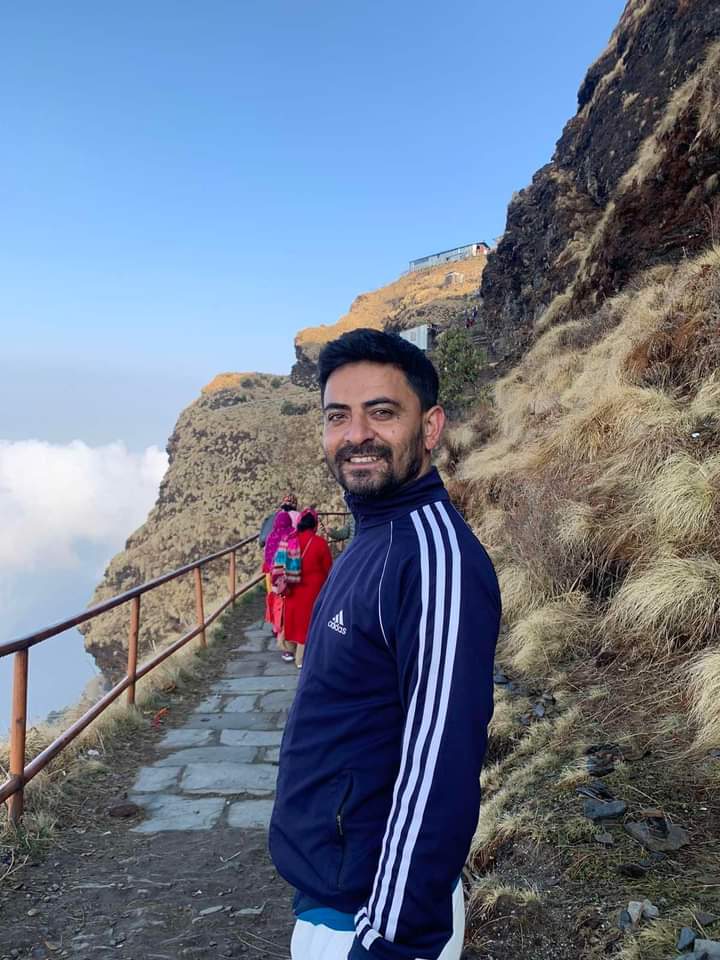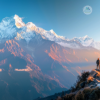We are always available for your help
Trip Facts
Some important facts about Mardi HImal Trek are as follows:
-
Max Altitude 4500m /14764.5 .ft
-
Difficulty Easy
-
Duration 11 Days
-
Trip Profile Mardi Himal Trek, Annapurna Region
-
Type Trekking
-
Accommodation 3 star hotel in Kathmandu and tea house during the trek
-
Meal Plan Breakfast in Kathmandu & Pokhara. Full board meals during trek.
Overview
Mardi Himal, popularly known as the hidden gem of Nepal is a new route on Annapurna region opened for trekking in 2012. Since its new route, the trail to Mardi Himal is no lesser than off-beaten trekking destination.
Positioning itself on the east side of Annapurna, Mardi Himal involves walking along forested zones filled with Rhododendron flowers followed by rocky mountain territory. The Gorkha regiment officer, Colonel jimmy Roberts quoted Mardi Himal trek as “the other sanctuary” is a perfect trek for trekking enthusiasts out there. In a short period, you get to see Annapurna South, Hiunchuli, Machhepuchhre, Gangapurna, Annapurna-I all at once. It’s a complete package for the trekkers who have limited stay in Nepal.
Highlights:
Dhaulagiri, Nilgiri, Annapurna South, Machhapuchhre, scenic villages, colourful rhododendron, oak forest, landscapes, organic lifestyles, the remote route
11 Day(s) Detailed Itinerary
Arrival on:Kathmandu, Nepal
Departure from: Kathmandu, Nepal
Arrival in Kathmandu
-
Accomodation: Hotel
-
Meals: Welcome Drink
-
Elevation: 1350m
Kathmandu Sightseeing
-
Accomodation: Hotel
-
Meals: Breakfast
Drive to Pokhara
-
Accomodation: Hotel
-
Meals: Breakfast
Drive to Kande and Trek to Pritam Deurali
-
Accomodation: Tea House
-
Meals: Breakfast, Lunch & Dinner
-
Elevation: 2600m
-
Duration: 5-6 hours
Trek to Forest camp
-
Accomodation: Tea House
-
Meals: Breakfast, Lunch & Dinner
-
Elevation: 3150m
-
Duration: 3-4 hours
Trek to High Camp
-
Accomodation: Tea House
-
Meals: Breakfast, Lunch & Dinner
-
Elevation: 2580m
-
Duration: 5-6 hours
Trek To Mardi Himal Base Camp & Trek To Sidding
-
Accomodation: Tea House
-
Meals: Breakfast, Lunch & Dinner
-
Elevation: 3580m
-
Duration: 5-6 hours
Trek to Luwang Village
-
Accomodation: Tea House
-
Meals: Breakfast, Lunch & Dinner
Drive to Pokhara
-
Accomodation: Hotel
-
Meals: Breakfast
Drive back to Kathmandu
-
Accomodation: Hotel
-
Meals: Breakfast
Final Departure
-
Accomodation: Hotel
-
Meals: Breakfast
What's included ?
- A porter and his entire expenses.
- Airport pickup and drop facility.
- Breakfast,Lunch and dinner during the trek.
- Down jackets and sleeping bags (provided upon request).
- First aid medical kit
- Fresh seasonal fruits after the dinner (while on the trek).
- Full day guided city tour in Kathmandu (Day 2) by a private vehicle.
- Insurance of guide and porter.
- Kathmandu-Pokhara-Kathmandu travel in a deluxe bus.
- Licensed, experienced and English speaking trekking guide.
- Lodge expenses during the trek.
- One porter for two people.
- Stay in the city at finest hotel (3 nights twin sharing room at Kathmandu and 2 nights at Pokhara).
- Upscale Adventures duffel bag, t-shirt, and trekking map.
- Welcome and farewell dinner at one of the finest Nepalese Restaurant with traditional ethnic music and dance.
What's not included ?
- Cost for additional trips.
- Extra night accommodation in Kathmandu in case of early arrival, late departure, and early return from the mountain(due to any reason) than the scheduled itinerary
- Extra porter charge.
- International airfare to and from Kathmandu
- Lunch and dinner in Kathmandu and Pokhara
- Meals in the city except for breakfast and other mentioned special dinner.
- Nepal arrival visa.
- Personal expenses (phone calls, laundry, bar bills, battery recharge, extra porters, bottle or boiled water, shower, etc.)
- Tipping to staffs (as an appreciation).
- Travel insurance which covers emergency rescue and evacuation
What is the Mardi Himal Trek and what makes it unique?
The Mardi Himal Trek is a relatively new and less frequented trekking route nestled within Nepal’s iconic Annapurna region. It distinguishes itself by offering uniquely intimate and panoramic views of towering peaks, including Annapurna I, Annapurna South, Hiunchuli, the distinctive Machapuchare (Fishtail), and the distant Dhaulagiri range. Unlike some of the more established trails, this trek provides a profound sense of solitude, allowing trekkers to immerse themselves in the pristine natural beauty of a remote corner of Nepal.
The journey itself traverses incredibly diverse landscapes, transitioning from lush, vibrant rhododendron forests and dense woodlands at lower altitudes to expansive, high-altitude alpine meadows as one ascends. The trek culminates at the breathtaking Mardi Himal Base Camp, offering a truly spectacular reward. The emphasis on a “less crowded” and “remote” experience is a significant draw for many adventurers. In a world where popular trekking destinations can sometimes feel bustling, the tranquility and untouched natural environment of Mardi Himal offer a distinct advantage, appealing to those who seek a peaceful communion with the Himalayas away from the usual throngs. This positioning allows the trek to attract individuals who prioritize an authentic, serene encounter with nature.
How long is the Mardi Himal Trek and what is its difficulty level?
The Mardi Himal Trek typically spans between 7 to 10 days, with many popular itineraries, including the comprehensive 7-day option, designed to provide a fulfilling experience. In terms of physical demand, the trek is classified as “moderately challenging”. This classification indicates that while trekkers will engage in several hours of walking each day across varied terrain, including sustained uphill and downhill sections, it is generally considered less arduous than some of the longer, higher-altitude expeditions in the Annapurna region, such as the Annapurna Circuit.
A reasonable level of physical fitness is recommended to fully enjoy the journey, but extensive prior trekking experience is not a strict prerequisite. This balance between adventure and accessibility broadens the trek’s appeal, making it suitable for a wide range of adventurers, including those who may be new to multi-day trekking but possess a good general fitness level. The “moderately challenging” designation effectively manages expectations, ensuring that prospective trekkers understand the demands while recognizing that the trek is attainable for many active individuals.
When is the best time to embark on the Mardi Himal Trek for optimal views and weather?
The prime seasons for undertaking the Mardi Himal Trek are Spring (early March to mid-May) and Autumn/Fall (early October to mid-December). During these periods, trekkers can expect stable, pleasant weather conditions, consistently clear skies, and unparalleled panoramic mountain views. Spring offers the added spectacle of vibrant rhododendron forests in full bloom, painting the hillsides with brilliant colors, creating a visually stunning backdrop to the trek. Autumn, on the other hand, is renowned for its crisp air and exceptionally clear visibility, providing some of the most breathtaking mountain vistas.
While the Mardi Himal Trek can technically be undertaken year-round, other seasons present significant challenges. The monsoon season (June to early September) is generally not recommended due to daily heavy rainfall, which leads to muddy and slippery trails, increased leech activity, and views frequently obscured by clouds and fog. Winter (December to February) brings extremely cold temperatures and significant snowfall at higher altitudes, which can render trails impassable and lead to the closure of teahouses, though it offers a unique, stark beauty for highly experienced winter trekkers. Providing this detailed seasonal advice empowers trekkers to plan their trip during conditions that maximize enjoyment and safety, ensuring a more fulfilling experience.
What permits are required for the Mardi Himal Trek?
Yes, two essential permits are legally required for undertaking the Mardi Himal Trek: the TIMS (Trekkers’ Information Management System) card and the Annapurna Conservation Area Permit (ACAP). These permits are fundamental for regulating trekking activities within the region, contributing to the safety and well-being of trekkers, and supporting the vital conservation efforts within the Annapurna Conservation Area. These permits are typically obtained in Kathmandu or Pokhara.
For the convenience of trekkers, comprehensive trek packages often include the arrangement and cost of obtaining these necessary permits, thereby simplifying the bureaucratic process. The consistent requirement for these permits across various Annapurna region treks underscores their universal importance. Including permit acquisition within a package removes a significant logistical burden and potential source of confusion for international travelers, enhancing the perceived value of the trek package and signaling a hassle-free experience.
Is a guide and porter necessary for the Mardi Himal Trek?
Yes, as of March 2023, the Government of Nepal has made it mandatory for all trekkers to hire a licensed trekking guide through an authorized trekking agency for treks across Nepal. While some historical perceptions might suggest the Mardi Himal Trek could be managed independently, having an experienced, English-speaking guide is now a legal requirement and provides invaluable benefits that extend far beyond mere compliance.
A guide serves as the primary point of contact, expertly handling navigation through varied terrain, ensuring safety on the trails, managing accommodation bookings, facilitating food orders, and overseeing porters. A comprehensive package typically includes a dedicated guide with all their expenses covered, encompassing salary, accommodation, meals, and insurance. Furthermore, a strong and helpful porter is included, with one porter typically assigned for every two trekkers, carrying up to 12kg per person to significantly lighten the load. For larger groups of 8 or more trekkers, an assistant guide is also provided to ensure personalized attention and enhanced safety throughout the journey. This mandatory requirement, when communicated effectively, transforms into a significant value proposition, offering peace of mind, cultural immersion, and expert logistical support.
What level of physical fitness is recommended for the Mardi Himal Trek?
Given that the Mardi Himal Trek is categorized as “moderately challenging,” a good baseline of physical fitness is certainly recommended to fully enjoy the experience. Trekkers should be comfortable with sustained walking for several hours each day, including ascending and descending varied terrain. While it is not necessary to be an elite athlete, engaging in regular cardiovascular exercises such as hiking, jogging, swimming, or cycling in the months leading up to the trek will significantly enhance stamina and overall enjoyment. Incorporating some strength training for the legs and core can also be highly beneficial.
Prior multi-day trekking experience is advantageous but not strictly required; the key is to prepare the body to handle continuous physical activity and adapt gradually to higher altitudes. Providing actionable advice on specific types of fitness preparation empowers prospective trekkers, setting realistic expectations for the physical demands of the trek. This proactive training directly contributes to a safer and more enjoyable experience, allowing individuals to approach the adventure with confidence.
What essential equipment should I pack for the Mardi Himal Trek, and can I rent gear in Nepal?
Packing smartly and efficiently is paramount for the Mardi Himal Trek. Essential items to consider include an all-season sleeping bag, a warm down jacket, a durable duffel bag (for your porter to carry), a wind and waterproof thin-layered jacket (often called a shell jacket), and a comfortable daypack for your daily essentials. Appropriate layering for both upper and lower body is crucial, including long-sleeve t-shirts, thermal tops, a wool jacket or pullover, thermal underwear, windproof and waterproof trousers, and comfortable trekking pants. For footwear, good waterproof trekking boots are essential, complemented by a pair of sandals for evenings and several pairs of woolen socks.
Other vital items include headwear (a warmer hat that covers the ears, a neck warmer), eyewear (sunglasses), high-SPF sunscreen (35-60 SPF), a headlamp with extra batteries, and a personal first-aid kit. Miscellaneous useful items typically include passport-size photos, a water bottle with a filter or purification tablets, a power bank for electronics, and a basic bathroom kit (toilet paper, hand wipes, soap).
To ease the packing burden and help manage costs, many companies provide an all-season sleeping bag, a down jacket, and a duffel bag for use during the trek, which are returned afterward. For other items, it is often more cost-effective and convenient to buy or hire trekking equipment like trekking poles and water purification tablets directly in Kathmandu or Pokhara, rather than purchasing them abroad or bringing them from home. This approach alleviates packing stress and reduces international luggage costs, making the trek more accessible.
What type of accommodation can I expect during the Mardi Himal Trek?
During the Mardi Himal Trek, the type of accommodation varies depending on the location. In cities like Kathmandu (if included in the package) and Pokhara, trekkers typically stay in comfortable 3-star hotels, offering modern amenities. However, once on the trekking trail, lodging transitions to local lodges or teahouses. At lower elevations, these teahouses may offer more comforts, sometimes even including attached bathrooms.
As the trek ascends to higher elevations, the accommodation becomes more basic, providing essential necessities such as solid beds with foam mattresses. Shared toilet facilities are common at these higher altitudes, and amenities like hot showers or battery charging may be available for an additional small fee. Clearly setting these expectations about the varying standards of teahouse accommodation is vital for trekker satisfaction, ensuring they are prepared for a rustic yet authentic experience that is integral to high-altitude trekking.
What kind of food will be provided on the Mardi Himal Trek, and are there dietary considerations?
All meals – breakfast, lunch, and dinner – are provided throughout the trekking days, with breakfast also included at the hotel in Pokhara. Trekkers can expect a diverse menu featuring Nepali, Continental, Tibetan, and Indian dishes. Popular local staples include hearty Dal Bhat (rice, lentil soup, and curry, often with the option of second helpings), Tibetan Bread, and Momo (dumplings). Fresh fruits are also provided nightly during the trek.
At higher elevations, food choices may become more limited, with potato dishes being a common and excellent source of carbohydrates, providing essential energy for high-altitude trekking. Prioritizing nutritious, freshly prepared, and sanitary food is a key focus. While on the trek, it is generally advised to avoid meat and dairy products due to potential refrigeration challenges in remote areas, and to stick to purified water to prevent gastrointestinal issues. Alcoholic drinks are also strongly advised against at high altitudes, as they can significantly hinder the body’s acclimatization process and exacerbate the risks of altitude sickness. This comprehensive approach to food and drink ensures both sustenance and safety on the trail.
What should I know about altitude sickness (AMS) on the Mardi Himal Trek, and how is it managed?
The Mardi Himal Base Camp reaches a significant elevation of 4,500 meters (14,764 feet), making altitude sickness, also known as Acute Mountain Sickness (AMS), a crucial consideration that can affect anyone, regardless of their age or physical fitness level. Trek itineraries are carefully designed with gradual ascents and appropriate acclimatization days to minimize this risk.
Common symptoms to watch for include headache, nausea, dizziness, fatigue, loss of appetite, and shortness of breath. Prevention is paramount: staying well-hydrated by drinking plenty of water, ascending slowly, and avoiding alcohol and tobacco are key measures. As a proactive safety measure, guides often carry an oxygen meter to check trekkers’ pulse, oxygen saturation, and heart rate twice daily, providing continuous monitoring for early signs of AMS.
Should symptoms appear, it is imperative to inform the guide immediately. The most effective treatment for AMS is immediate descent to a lower altitude. Guides are trained in wilderness first aid and possess the authority to make critical decisions regarding a trekker’s safety, including arranging emergency helicopter evacuation if necessary, with the cost typically covered by the trekker’s travel insurance. Consulting a doctor about Diamox (Acetazolamide) as a prophylactic measure before the trip is also often recommended. The company’s emphasis on proactive monitoring and clear emergency protocols transforms a potential fear into a managed risk, building significant trust with prospective trekkers.
What safety measures are in place during the Mardi Himal Trek?
The safety of trekkers is a top priority throughout the Mardi Himal Trek. Experienced trek leaders and guides are thoroughly trained in wilderness first aid and are equipped with necessary tools and first aid supplies to handle common medical issues on the trail. They continuously monitor trekkers’ health, including using an oxygen meter for proactive altitude sickness checks. Additionally, guides inspect the sanitation of meals and lodging to minimize health risks.
In the unlikely event of a serious medical emergency, the team is prepared to arrange a helicopter evacuation, with the cost covered by the trekker’s mandatory travel insurance. While guides prioritize group safety and navigational expertise, participants are also responsible for their own safety and must remain aware of their surroundings and physical condition at all times. Trekkers will receive instructions on how to act safely in the rare occurrence of natural hazards, such as earthquakes, which Nepal is prone to. This multi-layered approach to safety, encompassing trained personnel, preventative measures, and robust emergency protocols, aims to provide a secure and reassuring trekking environment.
What is your booking and cancellation policy for the Mardi Himal Trek?
To confirm a Mardi Himal Trek booking, a non-refundable deposit of 15% of the total trek cost, with a minimum of USD $350, is typically required. The remaining balance is due upon arrival in Kathmandu, preferably in USD, although other major currencies such as GBP, EUR, AUD, and CAD are generally accepted at current exchange rates. It is important to note that payments made by Visa or MasterCard usually incur an additional 5% fee to cover local taxes, bank charges, and transaction fees.
In situations where a trekker needs to cancel their trip, it is often possible to postpone the trek, and the deposit can be applied to a future trek date within six months of the original booking, provided sufficient notice is given. However, deposits are generally non-refundable as expenses are committed upon booking. A critical aspect of the policy is that if a trekker returns earlier from the trek due to sickness or any other personal problem, the money paid for flights, hotel, mountain room, food, and other services for the unused portion of the trip is non-refundable. In such cases, the trekker will also need to bear any additional expenses incurred for hotel, food, and other necessities in Kathmandu themselves. Clearly stating these terms is crucial for managing financial expectations and underscores the importance of obtaining comprehensive travel insurance to mitigate unforeseen circumstances.
Do I need a visa to enter Nepal for the trek?
Yes, a visa is required to enter Nepal for the trek. Most nationalities are eligible to obtain a “Visa on Arrival” at Kathmandu’s Tribhuvan International Airport. To facilitate this process, trekkers will need a passport that is valid for at least six months beyond their intended stay and contains at least one blank page for the visa stamp. The visa fee is typically paid in USD, with current rates being USD $30 for a 15-day visa or USD $50 for a 30-day visa. To expedite the process upon arrival at the airport, it is highly recommended to complete the online Tourist Visa Form beforehand. Providing this practical, up-to-date information on visa requirements simplifies a key pre-travel logistical step, making the arrival process smoother for international visitors.
Is travel insurance mandatory for the Mardi Himal Trek?
Yes, comprehensive travel insurance is absolutely mandatory for all participants undertaking the Mardi Himal Trek. This requirement is non-negotiable due to the inherent risks associated with high-altitude trekking and the remote nature of the region. A policy must explicitly include coverage for Emergency Medical Evacuation, specifically covering helicopter evacuation above the highest altitude of the trek (4,500m / 14,764ft). Additionally, coverage for Repatriation and Emergency Medical Expenses is essential.
It is the trekker’s sole responsibility to ensure their chosen policy covers all these critical requirements. Obtaining trip cancellation insurance is also highly recommended to protect against unforeseen circumstances such as illness, injury, or flight delays that might prevent the completion of the trek. The repeated emphasis on mandatory insurance, particularly for helicopter evacuation, highlights its critical importance as a safety net, protecting both the trekker’s well-being and the operational integrity of the trek.
How much should I tip my guide and porters after the Mardi Himal Trek?
Tipping your guide and porters is a customary practice in Nepal and serves as a meaningful way to express appreciation for their hard work, dedication, and invaluable support throughout your trek. While no specific percentage is officially recommended, the amount given should reflect the quality of service received and align with one’s personal financial means. Any amount, regardless of size, will make a significant difference to the guides, porters, and their families, contributing directly to their livelihoods. It is often a helpful and culturally appropriate gesture for trekkers to pool their tips as a group and present them collectively at the end of the trek. Providing this guidance helps trekkers navigate local cultural norms and ensures that the contributions of the support staff are appropriately recognized.
Departures
The given cost are per person and exclude international flights. Given below are the departure dates available for online booking. If the given date is not favorable then please write us and we will happily customize your trip on dates more appropriate for you.
Please Check Available Dates for The Year of:





